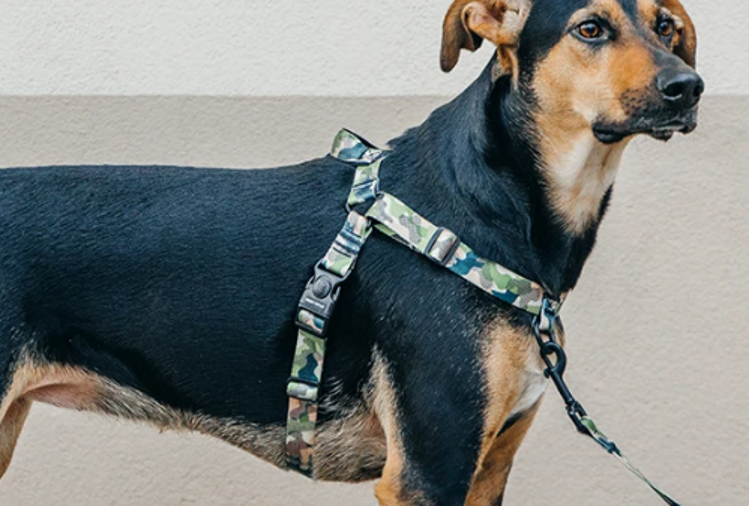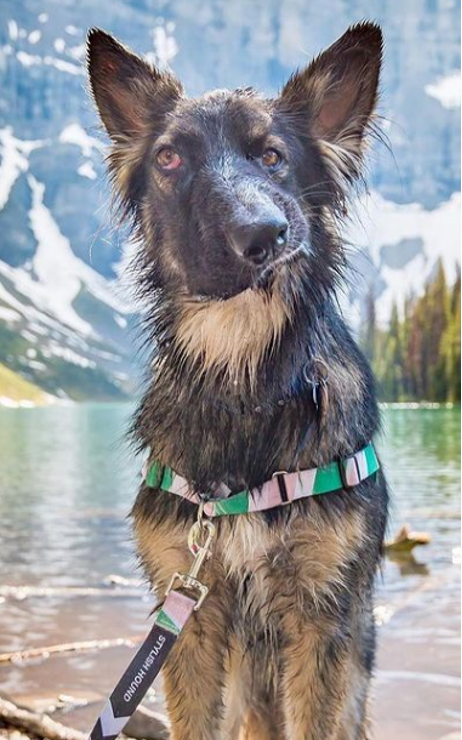Full disclosure: this article is incredibly biased and our agenda is pro-harness. If you’re seeking a balanced debate, look elsewhere! We do believe, however, that dog harnesses carry something of a stigma, and we’re here to rectify that. This is our justification for our biased post and we’re sticking with it!
Image: Stylish Hound
So, what’s the stigma, you ask? Well, when people think of dog harnesses, they tend to imagine poorly behaved dogs requiring extra restraint. To be fair, harnesses are used in such circumstances—and so they should be. Canine restraint and safety for all are the strongest arguments in favour of using a dog harness. The issue is when people can’t see beyond this. Harnesses are actually great for friendly dogs, too. Just because they’re friendly doesn’t mean a dog won’t pull!
There are a good number of reasons why you should use a dog harness—if it applies to your situation, of course. Hear our incredibly biased case below and then you can make up your own mind!
Using a dog harness: pros
- They’re a great training tool
Like their wolf ancestors, dogs are hardwired to run free. It shouldn’t be too surprising, then, that walking with restraint goes against every last instinct they feel in every last cell of their bodies. Throw in a dog’s opposition reflex and training can feel like an uphill battle.
Leash training is a separate post in itself, but in a nutshell, dog harnesses can be instrumental in correcting walking behaviours. When a dog pulls, it will experience unpleasant tension from the harness. The harness will also hold them back, and they will realise their pulling is inefficient in propelling them forward. Compare this to a leash-and-collar combination, where the dog is better equipped to pull itself forward. Without the harness, they are more likely to learn that pulling is an effective way to gain control during the daily walk.
- They provide better control
We touched on this above, and this point is fairly self-explanatory. Better control means better safety for all involved and surrounding you as you take your dog for a walk. This goes double when you’re walking by a busy road or through large crowds.
- They discourage jumping behaviours
We all know a dog who loves to jump. This is likely their way of giving a hug! However, jumping is a poor habit and should ideally be discouraged. By wearing a harness, the dog is pulled back in line without being choked. Think of it as a gentle deterrent.
Image: Stylish Hound
- They could save you on vet bills
When we walk a dog with a leash and collar alone, this puts pressure on the trachea. In worst-case scenarios, this can lead to a collapsed trachea—not to mention a big vet bill. Harnesses redistribute this tension to the torso, removing this choking hazard. In the case of pugs, excessive pressure around the neck can actually put their eyes at risk of protruding from their sockets. From a medical perspective, harnesses are safer all-round.
- They’re perfect for puppies
Puppies in particular are prone to pulling. Without a harness, they’re more likely to tangle themselves in knots or hurt themselves as they pull against their collars.
- They can provide the lift your dog needs
Sometimes, when we’ve been sitting on the ground for a while, we may ask someone for a hand off the ground. If your dog experiences the same issue, you can help them out by simply lifting the harness. It may provide just the momentum required!
- They’re super secure
We’ve all been in a harness at some stage of our lives—not a dog harness, but think back to school camp or similar. You needed to wear a harness to go on the large-scale flying fox! If you have even the vaguest memory of this, you’ll recall that harnesses don’t just fall off. They’re tightened securely and will hold in place. This is great news for your dog. Unlike collars, which aren’t entirely pull-proof, harnesses will stay in place. In fact, harnesses will hold the whole body in place regardless of how hard your dog is pulling. Your dog won’t slip out of it or break it.
Using a dog harness: cons
- Your dog might not like it at first
If your dog has been using a harness since puppyhood, there should be no issues. However, if you are introducing your dog to a harness later in life, they may be resistant at first. They may not like the feel of it, or they may not be used to having the harness attached and removed so frequently. This can be frustrating for you and your dog both, but persistence is key. Don’t give up at the first few signs of trouble!
No need to get your nose bent out of shape over a harness! Image: Stylish Hound
- Owners may forget the importance of the collar
Think a harness is a substitute for a collar? Think again. Collars are not just there to facilitate a leash clip. They’re also an important way to show that a dog does, in fact, have a home. On the off chance your dog were to go walkabout, a collar would immediately distinguish them from a stray. Moreover, the collar provides identifying information, giving your wandering dog the best chance of returning home safely. A harness is no substitute for a collar, so please don’t fall into the trap of thinking one can substitute the other. They’re each important in their own way.
- It may be difficult to find the right fit
Harnesses come in a range of sizes, so it may take a few tries before you’ve found the perfect fit. It’s important to find the right fit, too, lest it holds too tightly or chafes beneath the dog’s front legs. Like anything else, though, this hurdle is easily overcome with patience and persistence.
To harness or not to harness?
As you’ve likely gathered by now, we’re Team Harness. Any cons experienced are merely hurdles, and hurdles are an inherent part of dog ownership. It’s up to you to persevere in the interests of canine welfare and see these hurdles through.
Overall, harnesses make for a better walking experience all-round—be it from the perspective of control or trachea preservation. Just be wary that there are different harnesses to fit different purposes. Training harnesses are designed specifically for, well, training purposes. If you’re after a longer-term walk, you should look into chest plate harnesses or similar.
Finally, ensure you find the right fit! A harness should be firm yet comfortable. Just make sure you can fit two fingers beneath the fastened harness and you’ll be good to go. To better control and beyond!
Related Reading



